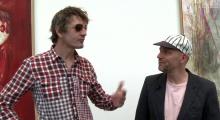326 Views
Themes
Medium
“The studio is the sponge and the outside world is the water … The sponge is dipped into reality and then squeezed out.” Daniel Richter, one of the most important painters of his generation, talks about the transformative power of painting.
“The studio is like a teenage room; you close the door from the inside and your mother isn’t allowed to come in. You don’t necessarily do anything forbidden or taboo, but it’s something you don’t want others to see,” says Richter jokingly of the work that goes on in the artist’s engine room. Multi-layered and crammed with historic and cultural references, his large-scale paintings come to life in the studio. “It’s like the brain,” he explains. “It inherits history and has different layers; language, music, memories, moods. It’s a place where you can analyse very precisely but you can also just drift.”
Richter came of age on the Hamburg punk scene where he produced record covers, band posters and political flyers, but he didn’t start painting until he was in his late twenties. “I wanted to bring as much information into a painting as possible, which was, on a very simple level, a way of coping with reality,” he says of his early work made in post-World War II Germany and marked by the 1990’s: the end of the Cold War, changing global relationships and the birth of the internet. Richter’s more recent work has transformed into more recognizable narratives, a kind of contemporary history painting: “When I changed to narration it was also an urge that had to do, on a very simple level, with reality … I felt the desire to paint things that related to what I saw in the world.” Not as a means of lecturing, explains Richter of his very political work, but as a way of working through the insecurity, fear and paranoia of being in the world. The key, he says, is to avoid distance and to make painting human: “The moment you take something that has a human effect on you, something you can’t describe, the whole thing transforms from a topic to something that is about yourself.”
Daniel Richter (b. 1962) is a German painter whose strongly coloured, often slightly surreal paintings convey current events and art historical issues with an irreverent and energetic approach. A professor at the Akademie der Bildenden Künste in Vienna, Austria, his work is widely exhibited, among others at Stedelijk Museum voor Actuele Kunst, The Netherlands, Hamburger Kunsthalle, Germany and Victoria Miro Gallery in London. Richter’s paintings can be found in the collections of the Museum of Modern Art, New York, the Centre Pompidou, Paris and elsewhere.
Daniel Richter was interviewed by Marc-Christoph Wagner in his studio in Berlin, Germany, and at Louisiana Museum of Modern Art, Denmark, in July 2016, in connection with the exhibition Lonely Old Slogans.
Camera: Klaus Elmer & Rasmus Quistgaard Produced by Marc-Christoph Wagner
Edited by: Klaus Elmer
Copyright: Louisiana Channel, Louisiana Museum of Modern Art, 2016
Comments
Brought to you by LOUISIANA






